

| On the morning of 21 Sep 2004, as I was completing my loop around Crespi
Pond on Pt. Pinos, I found an interesting Empidonax flycatcher.
To me it looked 'tiny,' short-tailed, short-billed, with a big round eyering,
on a bird that was green above and very bright yellow below. It also had
black wings with which the white wingbars and tertial edgings contrasted
strongly. This nice photo (above) by Blake Matheson captures all those
initial points about shape, size, and contrast.
And it gave a call I did not recognize: a sharp spweek! I could also write this skwee! or sqwee! or squee! as it varied slightly call to call (it called perhaps 8 times). It recalled the sharp spik! note of Nuttall's White-crowned Sparrow [they also have a soft seet — that is not the note of which I speak] but had a squeaky or sneezy quality to it, a little like a rubber ducky. This was odd because Pacific-slope Flycatchers nest in my backyard each year, and I think I know all of their calls. It was already late — after 9 a.m. — and I needed to get to work. So I tried a few digiscope pics (the bird was often cooperative in sitting on the fence surrounding the City's maintenance yard). There were numerous points that suggested Yellow-bellied Flycatcher to me but the call did not match the brief literature check I made (the Kaufmann Advanced Birding guide). I posted this as an interesting Empid on the local BirdBox. Here are some photos that either I or Blake Matheson (who visited the site later in the day in response to the BirdBox message) took. |
| The first things I noted were the small size, short tail, and a complete round eyering. It also looked short-billed in profile. This photo captures the short-tailed and short-billed look well. The entire upperparts were greenish-olive from crown to rump, and contrasted with much darker, essentially blackish, wings. The olive color also included the face. The bird did have a short crest that it often raised on alighting; when the crest wasn't up the bird looked very round-headed. At close range the two white wingbars were washed with a light orangey-yellow color. This bothered me. |
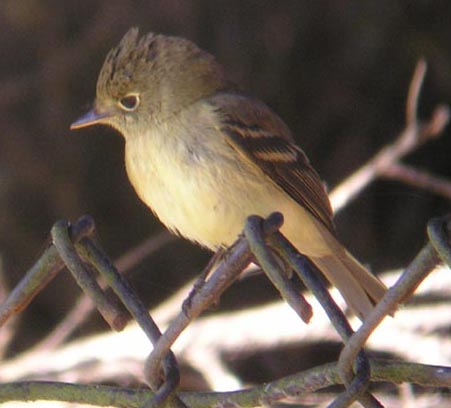 |
| Although the bird looked very short-tailed (again shown here) in all views, in some views (like this one from below) the bill suddenly looked disproportionately large. It was entirely pale on the lower mandible. The eyering was circular and of even thickness except it narrowed near top front and had the tiniest 'nootch' at the rear. At some times this latter point was noticeable and at other times it was not (compare the various photos). |
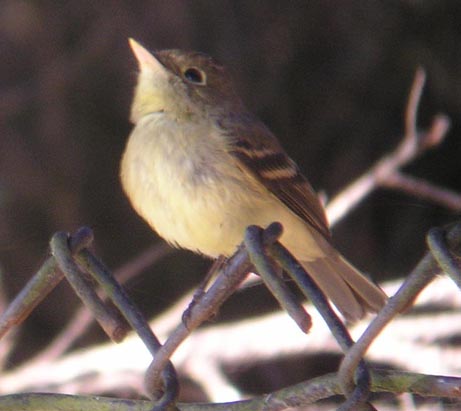 |
| In sunlight the bird was bright yellow below from chin & throat through undertail coverts. It color was a rich lemon yellow (the color of the belly/vent shown here). The color also showed nicely in the shade but the camera's overexposure of shaded photos wash it out. The back (and crown through rump) was a rather rich green-olive in the shade (without brownish tones), and so was the face (as here). Note also how little the bird looks on this chain-link fence. |
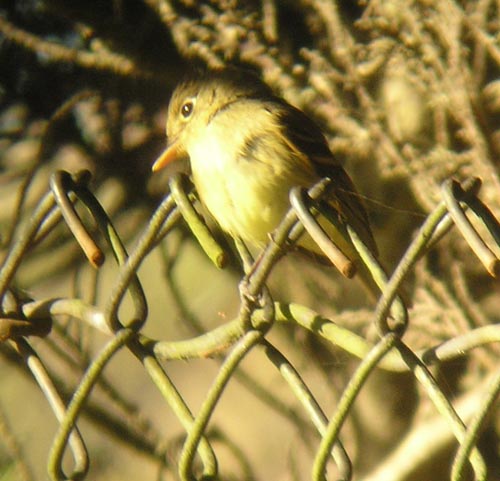 |
| This shaded shot washes out the yellow underparts by overexposure. But it does show another feature: the bird has an olive breastband, broadest on the sides of the breast and narrow in the center, that separated the pure yellow throat from pure yellow belly. In some lights the sides looked faintly streaked with this olive color. |
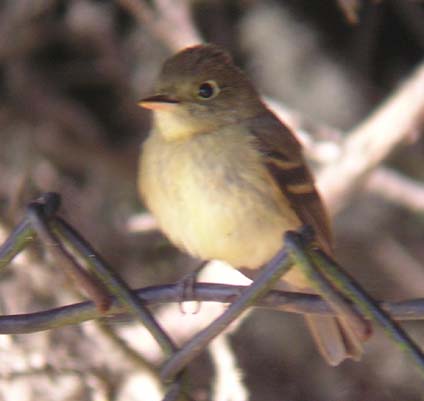 |
| This shot shows details of the eyering shape well. It also shows the
contrasting wingbars (essentially white or yellowy-white against blackish
upperwing coverts), and it shows the yellowish edges to the secondaries.
Both in the photos and in the field (with a scope) I could see that the
outermost primaries were emarginated but either p7 or p6 was not. The primary
projection looked to be medium or medium-short, but the tail was so short
this was hard for me to judge.
I cannot tell here (nor in the field) whether the marginal underwing coverts were yellow (good) or mustardy-yellow (bad). They look different in different shots. |
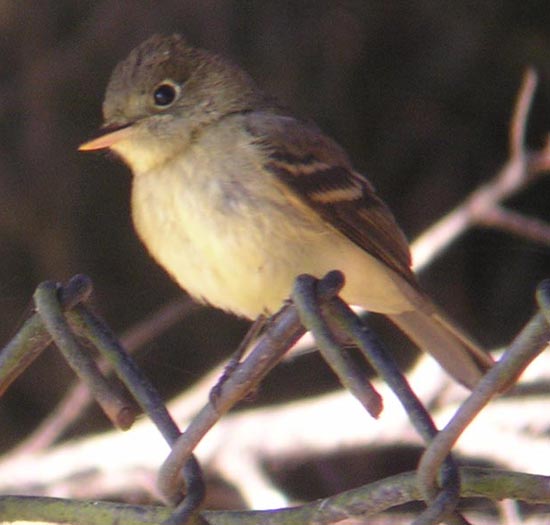 |
| Blake Matheson's photo (right) shows the olive green color of the head/back
nicely, and how it contrasted with the wings. It also contrasted with a
blackish tail. This shot also shows the broad white edge to the uppermost
tertial (seemingly covered half the feather); the lower tertials had crisp
white edges also but about half as broad as the upper one (see the photo
at top of page).
The legs were thin and dark but the tarsus looked a bit pale in strong lighting. |
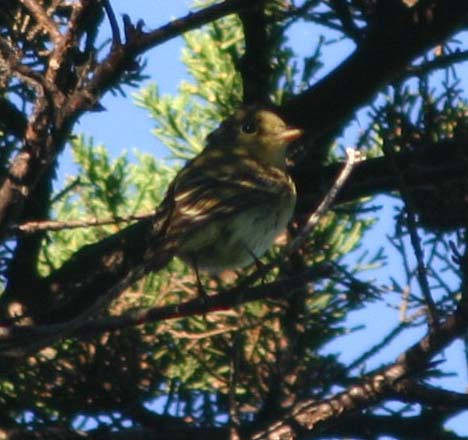 |
| I returned at 5 pm to look at the bird some more, and studied it over
the next 1.5 hours with Matt Brady, David Vander Pluym, Bob Tintle, and
Rita Carratello (not all were present the whole time). During this period
we had the bird under observation most of the time. It was very active,
foraging along the chain link fence and in Myioporums and low cypresses.
It often came to the ground or golfcourse grass to catch something, and
during bouts of foraging would vigorously pump its tail up on landing.
It did not flick its wings. At other times it went up into the canopy of
the cypresses and foraged inside the canopy. It seemed to avoid bright
sunshine and liked shade.
Vander Pluym had heard several calls before I arrived in the afternoon. During my 1.5 hours, it had a bout of calling — 6-8 calls — only once. Again they were the sharp, squeaky notes I had heard in the morning. I do not find this callnote described in Kaufman's Advanced Birding, or in the Birding series on Empids by Bret Whitney & Kenn Kaufman. Much later I found reference in Nat'l Geo and Sibley field guides to sneezy or wheezy notes that might qualify, but is my sqwee! the same as Sibley's "sharp monotone wsee"? I don't know. |
|
After posting the above photos and details, comments were requested from those reading various bird e-groups. A number of us also searched extensively for the flycatcher the next day, but it had gone. The skies had been clear all night and an offshore flow had developed. There were many new arrivals at Pt. Pinos on 22 Sep [including a calling Red-throated Pipit flying over the point] but no Empids. This update thus summarizes the comments received, and addresses some of them. Most importantly, I was able to review the fine paper by Matt Heindel & Peter Pyle on the separation of Yellow-bellied and 'Western' Flycatchers (1999) Birders Journal 8: 78-87. It appears that the characters of the Crespi bird match those considered important for identifying Yellow-bellied Flycatcher as detailed in that paper [see below]. Upon reading the paper, I also realized that one part of the details above was mistaken. I stated that "the outermost primaries were emarginated but either p7 or p6 was not." This was based on my assumption that the longest primaries — the wing tip itself — was formed by p8 and p9. This is wrong. The wing tip is formed by p7 and p8, the longest two primaries; in specimens of both species, p8 is the longest on about 40-50% of them (Heindel & Pyle 1999). My statement should read: "the outermost primaries were emarginated but either p6 or p5 was not." Pyle (1997) Identification Guide to North American Birds also shows this and explains that p6 is always emarginated on 'Western' Flycatchers and is often emarginated on Yellow-bellied Flycatcher. In both species, p5 is not emarginated. It thus seems probable that what I saw was an unemarginated p5, but that point is of no importance to the identification. |
Several writers offered comments on the call that was heard, and directed
me to on-line vocalizations. I did not personally have the software to
access all the calls, but a breeding-ground song and a call commonly given
by migrant Yellow-bellied Flycatcher is on the Cornell
site [thank you Tony Bledsoe for this link]. I very much like the squeaky
quality that I hear in elements of the song, but the rising tu-wee
callnote on that recording is not the one we heard. Several commentators,
however, stated that the sharp, squeaky call is a known vocalization of
Yellow-bellied Flycatcher. Most directly, Chris Benesh wrote:
"You raised the question of whether the call note fit for this species. As someone who sees a lot of these birds in winter in Belize and Guatemala, I just wanted to add that the sharp call you describe is the one commonly (almost exclusively) given by this species on its wintering grounds. So in my mind it looks very solid for being a Yellow-bellied Flycatcher."Three other very experienced observers felt that the call note was fine for Yellow-bellied Flycatcher, and no one has yet commented that they felt it was consistent with any 'Western' Flycatcher. |
| Matt Heindel (in comments) noted that the breastband streaking which I described did not show very well in the photos that were posted (above). I have looked through all the photos available, and post two more (below) that may better show this characters. I certainly had good views of olive streaking through the scope in the field, but only in some light conditions. [left © Blake Matheson — this shot was lightened and contrast enhanced slightly; right © D. Roberson] Whether you can clearly see the olive streaking on the breast, or at least the sides of the breast, may depend somewhat on your monitor. It is very apparent in mine. | |||
|
|||
| Heindel also wondered whether the spacing between the primary tips was examined in the field. Alas, it was not. This character, described in detail in Heindel & Pyle (1999), was not known to me at the time of observation. In short, Yellow-bellied has a more pointed wingtip than 'Western.' In Western there is an apparent gap between p5 and p6 while in Yellow-bellied p5 is longer and creates two smaller and more evenly spaced gaps between p5-p6 and between p6-p7 (Heindel & Pyle 1999). Another way to say the same thing is that the primary tips of Yellow-bellied fall more uniformly across the wingtip without an asymmetric gap. My digiscopes don't show the wingtips but photos by Blake Matheson do. Here is my best effort to look for this feature in photos: | |||
Some will say that the image is not crisp enough to make this comparison, and that is a fair critique. I think this analysis is suggestive only, but it does 'suggest' the same conclusion as the other features considered. |
Those commenting to date have mentioned three other items of interest
or concern:
|
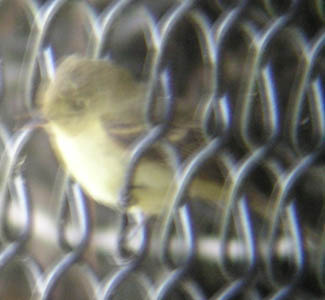
untouched digiscopes from early evening show color better but are not in focus |
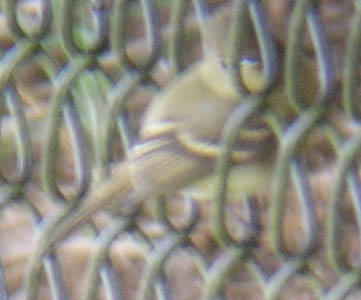
both shots here © D. Roberson and left untouched by PhotoShop (I could make them sharper but not 'sharp') |
|
|
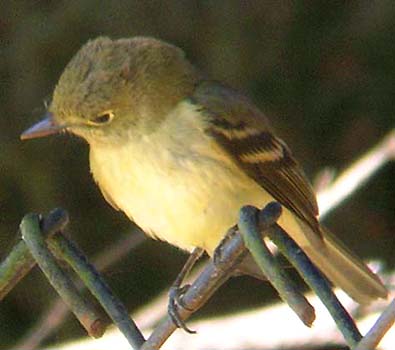 |
To summarize, following the points described in Heindel & Pyle
(1999) to separate between Yellow-bellied and 'Western' Flycatcher:
|
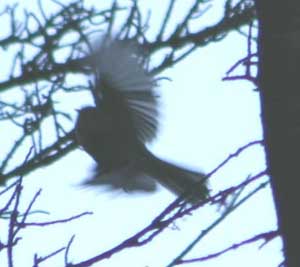 ACKNOWLEDGMENTS:
I thank David Vander Pluym, Matt Brady, Bob Tintle, and Rita Carratello
for their helpful discussions of the bird in the field. I am very grateful
to Blake Matheson for the use of his additional photos. My review of the
important paper by Heindel & Pyle (1999) was through the courtesy of
Joe Morlan and Dan Singer. I thank Chris Benesh, Tony Bledsoe, Steve Gerow,
Matt Heindel, Curtis Marantz, Guy McCaskie, Joe Morlan, and Scott Terrill
for their very helpful comments after reviewing the photos and details
that were posted late on 21 Sep 2004. ACKNOWLEDGMENTS:
I thank David Vander Pluym, Matt Brady, Bob Tintle, and Rita Carratello
for their helpful discussions of the bird in the field. I am very grateful
to Blake Matheson for the use of his additional photos. My review of the
important paper by Heindel & Pyle (1999) was through the courtesy of
Joe Morlan and Dan Singer. I thank Chris Benesh, Tony Bledsoe, Steve Gerow,
Matt Heindel, Curtis Marantz, Guy McCaskie, Joe Morlan, and Scott Terrill
for their very helpful comments after reviewing the photos and details
that were posted late on 21 Sep 2004.
I'd thank the bird for its presence, but it has (alas) flown away (right; © Blake Matheson). |
Use these links to reach other portions of the Monterey County list:
Part 1: Waterfowl through GrebesReaders may use this material for their own private enjoyment, study, or research but none of the photos or text herein may be used commercially nor may they be reposted on other web sites without written permission. All material is copyrighted. The posting of photos and text on this private web site is not a submission to review organizations.
Part 2: Albatrosses through Frigatebirds
Part 3: Herons through Cranes
Part 4: Plovers through Sandpipers
Part 5: Jaegers through Alcids
Part 6: Doves through Woodpeckers
Part 7: Flycatchers through Larks
Part 8: Swallows through Pipits
Part 9: Waxwings through Warblers
Part 10: Tanagers through Sparrows
Part 11: Grosbeaks through Finches
or just the plain Checklist (no annotations)